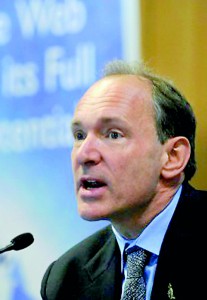Sunday Times 2
‘Vague but exciting’
Twenty five years ago today, a proposal was sent internally at a research company in Switzerland that was about to change the world.
Dubbed ‘Information Management: A proposal’, the document was created by a 34-year-old computer scientist called Tim Berners-Lee and was sent to his boss Mike Sendall.
That proposal, which Sendall described as ‘vague but exciting’ led to the development of the World Wide Web and, ultimately, the internet as we know it today.

Tim Berners-Lee
Sir Timothy Berners-Lee studied physics at Queen’s College Oxford before graduating in 1976. He then started as an engineer in the telecommunications and microprocessor software industry.
In 1980, while working as an independent contractor at CERN, Sir Berners-Lee described the concept of a global system based on using hypertext to share information between researchers.
He then built a prototype system called ENQUIRE, which formed the conceptual basis for the World Wide Web.
In 1989 he published his landmark paper, built the first server as well as the web browser ‘WorldWideWeb.app.’ The first website, based on these fundamental practices, then went live in August 1991. It
Sir Berners-Lee said: ‘In March 1989 I wrote a proposal for a universal linked information system that became the world wide web.
’25 years later, the web is a powerful enabler of people, economic activity and democracy – so important that some have argued that access to the web should be elevated to a human right.’
Lesley Cowley, chief executive officer of Nominet added: ‘The web is such as integral part of everyday life that we simply can’t live without it.
‘It has changed to something beyond what even Sir Tim and his colleagues could have imagined 25 years ago, when they were looking for an easier way to share and structure information.
‘The social, political and economic impact of the web makes it a story we are all part of, and to which we all contribute daily, whether that’s finding the answer to a question or connecting with friends and colleagues.’
Lea Simpson, strategy director, digital agency TH_NK on the 25th anniversary of the Web added:
‘It’s the open nature of the web that has made its impact so transformative.
‘It seems quite poetic that the opportunities of the next 25 years will depend on whether we – as users, businesses and governments – will maintain its libertarian spirit.
The internet, for example, is a network of networks that connects billions of computers together globally, but it is the World Wide Web – an information-sharing model built on top of the internet – that allows us to use the internet in the way we do today.
The World Wide Web was initially created to make it easier to share research papers. It is a system of interlinked ‘hypertext’ documents that are accessed via the internet; in essence, an information space.
The internet is actually much older than the web, and was born in a room in UCLA on October 24,1969.
While a grad student at MIT, Leonard Kleinrock developed a mathematical theory of packet switching, where data is broken up into ‘packets’ that can be exchanged over a network to allow users in multiple locations to access them.
The research was spotted by the Defence Department’s Advanced Research Projects Agency (ARPA-later named DARPA), which wanted to use it to distribute academic papers.
It wanted to test a network, and a contract was awarded to a team of computer engineers at Bolt Beranek and Newman (BBN), who built the Interface Message Processor, which was similar to the routers still used today.
The first node was placed at UCLA. the second at Stanford.
Leonard Kleinrock and his team sent a message to Stanford University using what we know know as the internet – only to find in crash after two letters.
© Daily Mail, London


